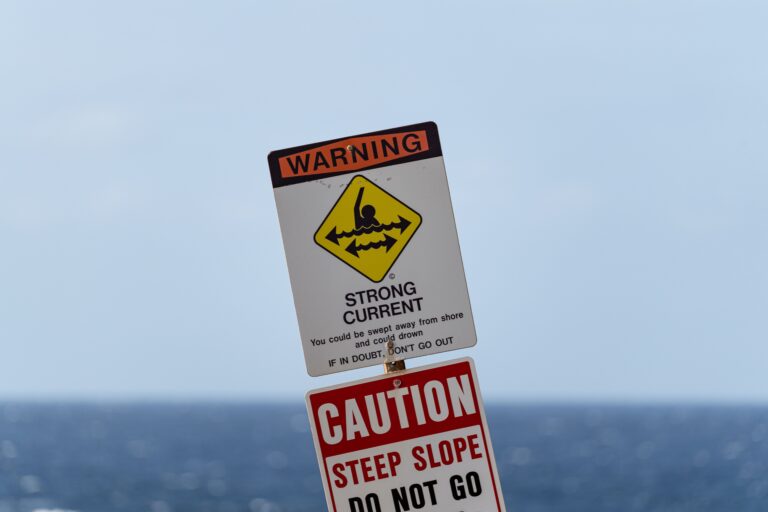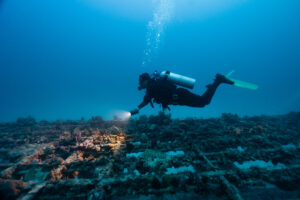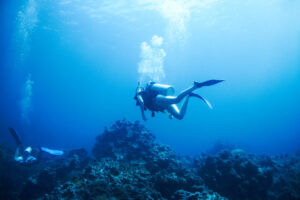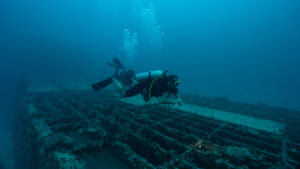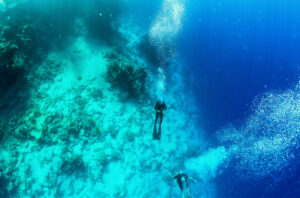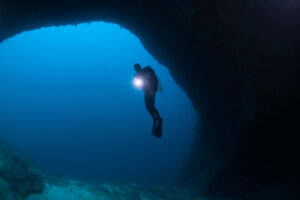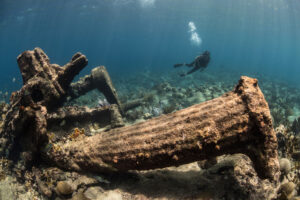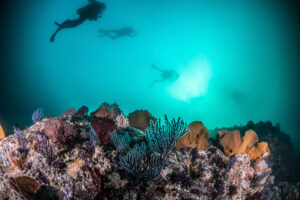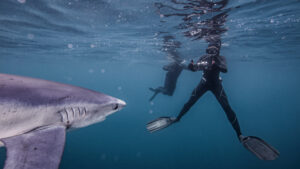What is a Rip Current?
A rip current, often simply called a rip, is a potent, localized and narrow current of water that moves directly away from the shore, cutting through the lines of breaking waves. It is a remarkable phenomenon that plays an integral role in the dynamics of the coastal environment and holds significant relevance for those who explore the undersea world, particularly scuba divers.
Formation and Identification
Rip currents form as waves travel from deep to shallow water, often breaking near the shoreline. These currents are most typically formed at low spots or breaks in sandbars, and near structures such as groins, jetties, and piers. Rip currents are complex, and their formation involves the interaction of wave heights, wave periods, bathymetry, beach slope, and the presence of coastal structures.
Identification of rip currents is a vital skill for any beachgoer and particularly crucial for divers. They are often discernible as a channel of churning, choppy water or an area having a notable difference in water color. They can also be recognized as a line of foam, seaweed, or debris moving steadily seaward, or a break in the incoming wave pattern.
Interactions with Swimmers and Divers
The strength and suddenness of rip currents make them hazardous to untrained or unaware swimmers. As they pull everything in their path away from shore, swimmers can be caught off-guard and carried out to sea. The United States Lifesaving Association estimates that rip currents account for over 80% of rescues performed by surf beach lifeguards.
For experienced scuba divers, however, rip currents can provide advantageous entry points to offshore dive sites. Divers can conserve energy and air supply by allowing the rip current to carry them out past the surf zone, an area often characterized by turbulent water and powerful waves. Once the rip current disperses, divers can descend and begin their exploration with minimal exertion.
Safety Considerations and Procedures
Despite their potential advantages, the power of rip currents should not be underestimated. It is essential for divers to possess a comprehensive understanding of their behavior, safety precautions, and escape procedures.
If caught in a rip current, the key to safety lies in not fighting the current. Instead, one should swim parallel to the shore until out of the force of the rip, and then swim back to land. For divers, if the current is too strong, it is advisable to descend to the bottom where the effect of the current is typically less.
In preparation for diving, divers should study local conditions and understand the behavior of rip currents in the area. It’s crucial to know the tides, as rip currents can be stronger and more hazardous during low tide when the water is pulling away from the shore.
Scientific and Environmental Importance
Rip currents also hold scientific significance. They contribute to the ocean’s circulation patterns by returning water carried shoreward by waves back to the sea. They are instrumental in distributing nutrients and organisms across different coastal zones, thus affecting marine biodiversity.
While rip currents are often viewed with apprehension, understanding their characteristics and behavior can turn them from potential hazards into beneficial tools for ocean exploration. With knowledge and respect, scuba divers can harness the power of rip currents to access the magnificent underwater world lying beyond the breakers.
As with all aspects of scuba diving, the key is education and preparation. A well-informed diver can manage the risks associated with rip currents and enjoy their advantages, reinforcing the old diving adage: “Plan your dive, and dive your plan.”
Understanding Rip Current Types
Three primary types of rip currents exist: flash, fixed, and permanent. Flash rips are temporary and form suddenly, lasting for only a few minutes. Fixed rips occur in places where there are constant low spots in the seabed. Permanent rips are found alongside fixed structures like reefs or piers. The type of rip current present can significantly impact how a diver approaches their entry and exit points during a dive.
Role in Underwater Navigation
Rip currents play an essential role in underwater navigation. They can act as markers or reference points for divers, helping them locate specific dive sites, especially in low visibility conditions. However, divers should be mindful of their direction and strength, as it can also lead to disorientation if not adequately managed.
Impacts on Marine Life
Marine life has a unique relationship with rip currents. These currents can bring in nutrients from deeper waters, promoting a rich variety of aquatic life in their vicinity. Many species of fish and other marine animals use the current for food foraging, making these areas abundant hunting grounds for divers. However, the strong force of the current can also make some marine creatures more elusive, adding a challenging element to underwater wildlife encounters.
Role in Dive Planning and Training
Understanding and recognizing rip currents should be a fundamental part of dive planning and diver training. Knowledge of how to use and escape these currents should be included in basic open water certification courses. Advanced courses may even offer specialized training to deal with strong currents and challenging sea conditions, enhancing a diver’s skill set and confidence.
Rip Currents in Different Diving Conditions
Rip currents can behave differently depending on the diving conditions. For example, in rough seas, the rip currents can be stronger and more dangerous. In contrast, during slack tide, when the tidal current is not moving much, rip currents may be weaker. Divers need to be aware of these changing conditions and adapt their dive plans accordingly.
The Future of Rip Current Research
As our understanding of the ocean and its complex systems grows, so too does our knowledge of rip currents. Research is ongoing in areas such as predicting rip current formation and behavior, improving safety measures, and understanding their impacts on coastal ecology. This research is essential for enhancing diver safety, improving rescue operations, and protecting our delicate marine ecosystems.
In conclusion, rip currents are a potent force in the marine environment. While they can pose a danger to the uninitiated, with the right knowledge and respect, they can be powerful allies to the scuba diver, aiding in navigation, conserving energy, and providing access to a rich array of marine life. Above all, understanding rip currents underscores the importance of education and preparation in ensuring safe and enjoyable underwater adventures.

